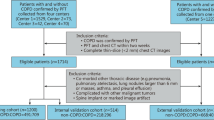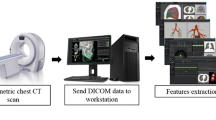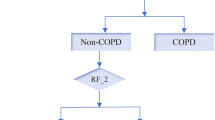Abstract
Objectives
To evaluate the value of CT-based whole lung radiomics nomogram for identifying the risk of cardiovascular disease (CVD) in patients with chronic obstructive pulmonary disease (COPD).
Materials and methods
A total of 974 patients with COPD were divided into a training cohort (n = 402), an internal validation cohort (n = 172), and an external validation cohort (n = 400) from three hospitals. Clinical data and CT findings were analyzed. Radiomics features of whole lung were extracted from the non-contrast chest CT images. A radiomics signature was constructed with algorithms. Combined with the radiomics score and independent clinical factors, multivariate logistic regression analysis was used to establish a radiomics nomogram. ROC curve was used to analyze the prediction performance of the model.
Results
Age, weight, and GOLD were the independent clinical factors. A total of 1218 features were extracted and reduced to 15 features to build the radiomics signature. In the training cohort, the combined model (area under the curve [AUC], 0.731) showed better discrimination capability (p < 0.001) than the clinical factors model (AUC, 0.605). In the internal validation cohort, the combined model (AUC, 0.727) performed better (p = 0.032) than the clinical factors model (AUC, 0.629). In the external validation cohort, the combined model (AUC, 0.725) performed better (p < 0.001) than the clinical factors model (AUC, 0.690). Decision curve analysis demonstrated the radiomics nomogram outperformed the clinical factors model.
Conclusion
The CT-based whole lung radiomics nomogram has the potential to identify the risk of CVD in patients with COPD.
Clinical relevance statement
This study helps to identify cardiovascular disease risk in patients with chronic obstructive pulmonary disease on chest CT scans.
Key Points
• To investigate the value of CT-based whole lung radiomics features in identifying the risk of cardiovascular disease in chronic obstructive pulmonary disease patients.
• The radiomics nomogram showed better performance than the clinical factors model to identify the risk of cardiovascular disease in patients with chronic obstructive pulmonary disease.
• The radiomics nomogram demonstrated excellent performance in the training, internal validation, and external validation cohort (AUC, 0.731; AUC, 0.727; AUC, 0.725).






Similar content being viewed by others
Data sharing
Data generated or analyzed during the study are available from the corresponding author by request.
Abbreviations
- AECOPD:
-
Acute exacerbation of chronic obstructive pulmonary disease
- AUC:
-
Area under the ROC curve
- CI:
-
Confidence interval
- COPD:
-
Chronic obstructive pulmonary disease
- CT:
-
Computed tomography
- CVD:
-
Cardiovascular disease
- DCA:
-
Decision curve analysis
- FEV1%:
-
Percent predicted of forced expiratory flow in 1 s
- FEV1:
-
Forced expiratory volume in 1 s
- ICD:
-
International Classification of Disease
- mRMR:
-
Maximal redundancy minimal relevance
- NPV:
-
Negative predictive value
- PPV:
-
Positive predictive value
- PRISm:
-
Preserved ratio impaired spirometry
- ROC:
-
Receiver operating characteristic
- VRF:
-
Vascular risk factors
References
David MGH, Gerard JC, Alberto P et al (2022) Global initiative for the diagnosis, management, and prevention of chronic obstructive lung disease. The 2020 GOLD Science Committee Report on COVID-19 and Chronic Obstructive Pulmonary Disease. Am J Physiol Lung Cell Mol Physiol 203(1):24–36
Wang C, Xu J, Yang L et al (2018) Prevalence and risk factors of chronic obstructive pulmonary disease in China (the China Pulmonary Health [CPH] study): a national cross-sectional study. Lancet 391(10131):1706–1717
Christenson SA, Smith BM, Bafadhel M et al (2022) Chronic obstructive pulmonary disease. Lancet 399(10342):2227–2242
Negewo NA, Gibson PG, McDonald VM (2015) COPD and its comorbidities: impact, measurement and mechanisms. Respirology 20(8):1160–1171
Zhao D, Liu J, Wang M et al (2019) Epidemiology of cardiovascular disease in China: current features and implications. Nat Rev Cardiol 16(4):203–212
Chen W, Thomas J, Sadatsafavi M et al (2015) Risk of cardiovascular comorbidity in patients with chronic obstructive pulmonary disease: a systematic review and meta-analysis. Lancet Respir Med 3(8):631–639
Austin V, Crack PJ, Bozinovski S et al (2016) COPD and stroke: are systemic inflammation and oxidative stress the missing links? Clin Sci (Lond) 130(13):1039–1050
Rabe KF, Hurst JR, Suissa S (2018) Cardiovascular disease and COPD: dangerous liaisons? Eur Respir Rev 27(149):180057
Morgan AD, Zakeri R, Quint JK (2018) Defining the relationship between COPD and CVD: what are the implications for clinical practice? Ther Adv Respir Dis 12:1753465817750524
Du Y, Li Q, Sidorenkov G et al (2021) Computed tomography screening for early lung cancer, COPD and cardiovascular disease in Shanghai: rationale and design of a population-based comparative study. Acad Radiol 28(1):36–45
Kockelkoren R, Jairam PM, Murchison JT et al (2018) Validation of an imaging based cardiovascular risk score in a Scottish population. Eur J Radiol 98:143–149
Balbirsingh V, Mohammed AS, Turner AM et al (2022) Cardiovascular disease in chronic obstructive pulmonary disease: a narrative review. Thorax Thoraxjnl 30:thoraxjnl-2021-218333
Cury RC, Leipsic J, Abbara S et al (2022) CAD-RADS™ 2.0 – 2022 coronary artery disease – reporting and data system an expert consensus document of the Society of Cardiovascular Computed Tomography (SCCT), the American College of Cardiology (ACC), the American College of Radiology (ACR) and the North America Society of Cardiovascular Imaging (NASCI). J Cardiovasc Comput Tomogr 16(6):536–557
Sergio HRRS, Amil MS (2021) Lung function and cardiovascular disease: a link. Trends Cardiovasc Med 31(2):93–98
Lambin P, Leijenaar RTH, Deist TM et al (2017) Radiomics: the bridge between medical imaging and personalized medicine. Nat Rev Clin Oncol 14(12):749–762
Mayerhoefer ME, Materka A, Langs G et al (2020) Introduction to radiomics. J Nucl Med 61(4):488–495
Ather S, Kadir T, Gleeson F (2020) Artificial intelligence and radiomics in pulmonary nodule management: current status and future applications. Clin Radiol 75(1):13–19
Qiu Y, Wang Y, Shen N (2022) Nomograms for predicting coexisting cardiovascular disease and prognosis in chronic obstructive pulmonary disease_ a study based on NHANES data. Can Respir J 2022:5618376
Chen QA-O, Pan T, Wang YN et al (2023) A coronary CT angiography radiomics model to identify vulnerable plaque and predict cardiovascular events. Radiology 307(2):e221693
Coats V (2018) DESPRéS J P, ALMéRAS N, et al Ectopic adiposity and cardiometabolic health in COPD. Int J Chron Obstruct Pulmon Dis 15(13):3331–3340
Labaki WW, Rosenberg SR (2020) Chronic obstructive pulmonary disease. Ann Intern Med 173(3):ITC17–ITC32
Halpin DA-O, Criner GJ, Papi A et al (2021) Global initiative for the diagnosis, management, and prevention of chronic obstructive lung disease. The 2020 GOLD Science Committee Report on COVID-19 and Chronic Obstructive Pulmonary Disease. Am J Respir Crit Care Med 203(1):24–36
Gomes AF, Brasil DM, Silva AIV et al (2020) Accuracy of ITK-SNAP software for 3D analysis of a non-regular topography structure. Oral Radiol 36(2):183–189
Wan ES, Balte P, Schwartz JE et al (2021) Association between preserved ratio impaired spirometry and clinical outcomes in US adults. JAMA 326(22):2287–2298
Zheng J, Zhou R, Zhang Y et al (2023) Preserved ratio impaired spirometry in relationship to cardiovascular outcomes: a large prospective cohort study. Chest 163(3):610–623
WHITTAKER HR, BLOOM C, MORGAN A, et al (2021) Accelerated FEV1decline and risk of cardiovascular disease and mortality in a primary care population of COPD patients. Eur Respir J 4;57(3):2000918
Kunisaki KA-O, Dransfield MT, Anderson JA et al (2018) Exacerbations of chronic obstructive pulmonary disease and cardiac events. A post hoc cohort analysis from the SUMMIT randomized clinical trial. Am J Respir Crit Care Med 198(1):51–57
Løkke AA-O, Hilberg OA-O, Lange PA-O et al (2023) Exacerbations predict severe cardiovascular events in patients with COPD and stable cardiovascular disease-a nationwide, population-based cohort study. Int J Chron Obstruct Pulmon Dis 18:419–429
Yakar HI, Kanbay A (2020) Could monocyte level/HDL cholesterol ratio predict cardiovascular diseases in patients with COPD? Niger J Clin Pract 23(4):450–455
Li J, Wang Q, Zhang Q et al (2020) Higher blood vascular cell adhesion molecule-1 is related to the increased risk of cardiovascular events in chronic obstructive pulmonary disease. Int J Chron Obstruct Pulmon Dis 15:2289–2295
Rizzo S, Botta F, Raimondi S et al (2018) Radiomics: the facts and the challenges of image analysis. Eur Radiol Exp 2(1):36
Huang W, Deng H, Li Z et al (2023) Baseline whole-lung CT features deriving from deep learning and radiomics: prediction of benign and malignant pulmonary ground-glass nodules. Front Oncol 13:1255007
Zhou T, Tu W, Dong P et al (2023) CT-based radiomic nomogram for the prediction of chronic obstructive pulmonary disease in patients with lung cancer. Acad Radiol S1076–6332(23):00139–00143
Pujadas ER, Raisi-Estabragh Z, Szabo L et al (2023) Prediction of incident cardiovascular events using machine learning and CMR radiomics. Eur Radiol 33(5):3488–3500
Yang M, Cao Q, Xu Z et al (2022) Development and validation of a machine learning-based radiomics model on cardiac computed tomography of epicardial adipose tissue in predicting characteristics and recurrence of atrial fibrillation. Front Cardiovasc Med 9:813085
Funding
This study has received funding by the National Key R&D Program of China (2022YFC2010002, 2022YFC2010000); the National Natural Science Foundation of China (82171926, 81930049, 81871321); the Medical Imaging Database Construction Program of National Health Commission (YXFSC2022JJSJ002); the Clinical Innovative Project of Shanghai Changzheng Hospital (2020YLCYJ-Y24); and the program of Science and Technology Commission of Shanghai Municipality (21DZ2202600).
Author information
Authors and Affiliations
Corresponding author
Ethics declarations
Guarantor
The scientific guarantor of this publication is Li Fan.
Conflict of interest
The authors of this manuscript declare no relationships with any companies, whose products or services may be related to the subject matter of the article.
Statistics and biometry
One of the authors (TaoHu Zhou) has significant statistical expertise.
Informed consent
Written informed consent was waived by the Institutional Review Board.
Ethical approval
Institutional Review Board approval was obtained (2022SL068).
Study subjects or cohorts overlap
No study subjects or cohorts have been previously reported.
Methodology
• retrospective
• observational
• multicenter study
Additional information
Publisher's note
Springer Nature remains neutral with regard to jurisdictional claims in published maps and institutional affiliations.
XiaoQing Lin and TaoHu Zhou contributed equally to this work.
Rights and permissions
Springer Nature or its licensor (e.g. a society or other partner) holds exclusive rights to this article under a publishing agreement with the author(s) or other rightsholder(s); author self-archiving of the accepted manuscript version of this article is solely governed by the terms of such publishing agreement and applicable law.
About this article
Cite this article
Lin, X., Zhou, T., Ni, J. et al. CT-based whole lung radiomics nomogram: a tool for identifying the risk of cardiovascular disease in patients with chronic obstructive pulmonary disease. Eur Radiol (2024). https://doi.org/10.1007/s00330-023-10502-9
Received:
Revised:
Accepted:
Published:
DOI: https://doi.org/10.1007/s00330-023-10502-9




